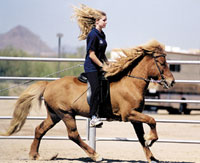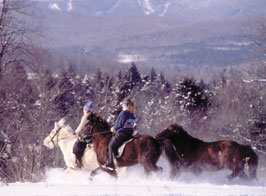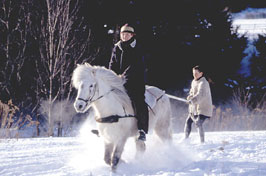
|
Return to Breed Profiles Main Page
Icelandic HorseThe Biggest
Little Horse in the World Proving the old adage that good things come in small packages, the Icelandic Horse averages a whopping 13.2 hands tall - on the outside. For some reason,
Americans can't resist the urge to "correct" the term Icelandic
Horse and refer to them as ponies. 1000 Year
History The available
steeds were no doubt direct descendants of Celtic pony native to
those regions, In the twelfth century, the Icelandic parliament, the Althing (now the oldest parliament in the world) declared a ban on importing horses, in order to prevent a disastrous outbreak of disease. In the 800+ years since then, the horses have remained absolutely pure of blood, very likely making the Icelandic Horse the oldest purebred horse in the world. Shaped by
the Land Cold weather and scant food evolved the horses into compact animals with less surface area for body heat loss, long, dense coats, and slower metabolisms. The rough traveling conditions fostered the agility and surefootedness that evolved into at least five distinct gaits; walk, trot, tolt (even, four-beat), pace and canter. Although breeding
standards were set by the settlers and followed until around 1300,
the terrain and climate of Iceland, more than man-made ideals, shaped
the form and character of the horse. Roads By 1783 a census counted 32,200 horses on the island. The following year, murderous weather, volcanic eruptions and food shortages annihilated all but 8,600 survivors. The 150,000 to 200,000 Icelandic Horses worldwide today, are descended from those toughest of the tough. Icelandic
Charm Natural selection
has contributed to some unusual qualities, including the ability
to digest cellulose better than other horses (greater large intestine
surface area), high cell content of readily metabolizable fat, low
hemoglobin blood count (often mis-diagnosed as "anemia"), a high
Other traits also trace directly to the unique development of the breed. It is said that the lack of natural predators over the last 1200 years has nearly eliminated the "fight or flight" response. Having traditionally been pastured in groups, the herd instincts are very strong and Icelandics tend to wilt if isolated from other horses. Most are naturally gaited, though there are three-gaited strains, proving that even in the purest of bloodlines, the genetics of gait is still a puzzle. Their "Thelwell pony" looks are accentuated by thick, lustrous manes that often part down the center of the neck and flounce to both sides. Horses come in every imaginable equine coat color combination, excluding Appaloosa. The most prized horses in Iceland have a quality called "go-eyness", meaning they are eager to move out. Such horses often take newcomers to the breed by complete surprise as the "shaggy little pony" image thunders out from under them. Generally less "spooky" than a lot of breeds, the Icelandic is calm and accepting by nature. Centuries of enduring genuine hardships have weeded out frivolous overreaction. They tend not to kick as they have had to huddle together for warmth and protection from the elements for untold generations.
Icelandics around the world are evaluated under a system called Blup (see TGH, Spring 2000), which condenses scores earned under various judges for such traits as conformation, straightness of feet, willingness and appearance under rider, into a single numerical score. Afficionados can tell at a glance, the merit of any given horse. For
more information on Icelandic Horses contact: |

 There
is a perfectly logical explanation for this, which doesn't make
it any less irrelevant. Whether you call them ponies, horses, equines,
pferde or gæðingurs, these powerful mounts will earn your respect
and steal your heart, if you give them the chance.
There
is a perfectly logical explanation for this, which doesn't make
it any less irrelevant. Whether you call them ponies, horses, equines,
pferde or gæðingurs, these powerful mounts will earn your respect
and steal your heart, if you give them the chance. to
which the Icelandic Horse bears a strong resemblance to this day.
Stocky, sturdy, strong and strong-willed, not unlike the people
that brought them, the horses had to endure great hardships, on
the sea journey and once again on land. Imagine the scene of horses
being loaded on to open longboats and envision for yourself the
qualitites necessary. Willingness, trust, agility and physical toughness
had to have been paramount. Smaller size may have been an asset
in accommodating as many horses as possible, and it stands to reason,
that only the very best horses would be worth the trouble.
to
which the Icelandic Horse bears a strong resemblance to this day.
Stocky, sturdy, strong and strong-willed, not unlike the people
that brought them, the horses had to endure great hardships, on
the sea journey and once again on land. Imagine the scene of horses
being loaded on to open longboats and envision for yourself the
qualitites necessary. Willingness, trust, agility and physical toughness
had to have been paramount. Smaller size may have been an asset
in accommodating as many horses as possible, and it stands to reason,
that only the very best horses would be worth the trouble. were
treacherous to non-existent, the distance between destinations far
and often impeded by obstacles from mountains to volcanoes, from
quicksand to lavaflows, or by vicious weather, from howling bitter
winds to blinding snowstorms. The horses had to be surefooted, extremely
hardy, and independent just to survive their home, and obedient,
smooth-riding and possessed of great stamina to avoid becoming their
master's dinner. A good horse was the prize and delight of his owner.
were
treacherous to non-existent, the distance between destinations far
and often impeded by obstacles from mountains to volcanoes, from
quicksand to lavaflows, or by vicious weather, from howling bitter
winds to blinding snowstorms. The horses had to be surefooted, extremely
hardy, and independent just to survive their home, and obedient,
smooth-riding and possessed of great stamina to avoid becoming their
master's dinner. A good horse was the prize and delight of his owner. ratio
of red to white muscle fibers (red burn oxygen more efficiently
than white), high fertility and easy foaling. They are long-lived.
One mare, named Tulle, was documented to have been 57 years old.
ratio
of red to white muscle fibers (red burn oxygen more efficiently
than white), high fertility and easy foaling. They are long-lived.
One mare, named Tulle, was documented to have been 57 years old.